The global glass container market is projected to grow from USD 68.5 billion in 2025 to approximately USD 187.6 billion by 2035, recording an absolute increase of USD 118.8 billion over the forecast period. This translates into a total growth of 173.4%, with the market forecast to expand at a CAGR of 10.6% between 2025 and 2035. The market size is expected to grow by approximately 2.7X during the same period, supported by increasing demand for premium packaging solutions, growing adoption across beverage and food industries, and rising requirements for eco-conscious packaging alternatives across global consumer goods and retail sectors.
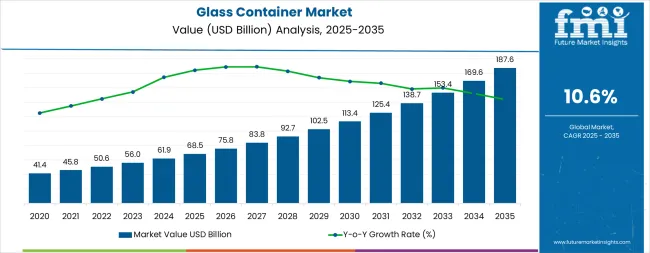
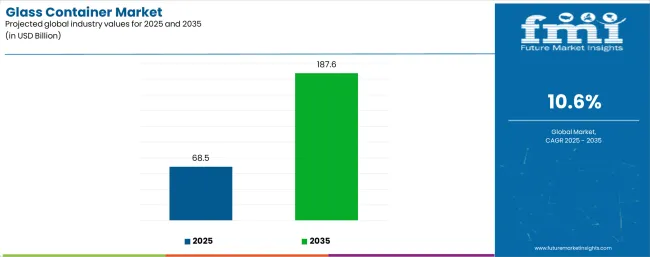
Between 2025 and 2030, the glass container market is projected to grow from USD 68.5 billion to USD 113.6 billion, adding USD 45.1 billion, which accounts for 38% of the total decade growth. This phase will be driven by the rising demand for premium packaging, increasing consumer preference for recyclable materials, and wider availability of specialized glass containers in retail and hospitality sectors. Between 2030 and 2035, the market is expected to expand from USD 113.6 billion to USD 187.6 billion, contributing USD 73.7 billion or 62% of the growth. This period will witness advancements in lightweight manufacturing technologies, innovative decoration techniques, and customizable packaging solutions. The focus on product presentation and premium packaging will increase demand for high-quality glass containers with enhanced aesthetic appeal, superior barrier properties, and improved freshness.
| Metric | Value |
|---|---|
| Estimated Value in (2025E) | USD 68.5 billion |
| Forecast Value in (2035F) | USD 187.6 billion |
| Forecast CAGR (2025 to 2035) | 10.6% |
The packaging industry is the largest contributor, accounting for around 35-40%. Glass containers are highly sought after for their superior ability to preserve product quality, making them ideal for packaging premium food, beverages, and cosmetics. They are especially favored for products like wine, spirits, and luxury cosmetics due to their aesthetic appeal, as well as their ability to protect against contaminants without altering the contents. The food and beverage market, contributing around 25-30%, uses glass containers extensively for packaging liquids, preserves, sauces, and beverages, as glass does not interact with the product, preserving freshness and taste. The growing trend towards natural and preservative-free food products further boosts the demand for glass packaging.
The cosmetics and personal care market holds a share of approximately 10-15%, where glass is widely used for packaging skincare products, perfumes, and high-end beauty items. Glass containers provide a premium feel and offer excellent protection for these sensitive products. The pharmaceutical packaging market, contributing around 10-12%, relies on glass containers for their chemical inertness and ability to preserve the quality and potency of medicines, especially injectables and vaccines. The chemical and industrial market accounts for 5-8%, where glass containers are used for packaging chemicals, solvents, and industrial products due to their ability to prevent contamination and ensure product stability.
Market expansion is being supported by the increasing global demand for premium packaging solutions and the corresponding shift toward high-quality containers that can provide superior preservation outcomes while meeting brand requirements for visual appeal and reliable product protection processes. Modern manufacturers are increasingly focused on incorporating packaging solutions that can enhance product differentiation while satisfying demands for durable, consistently performing containers and optimized presentation practices. Glass containers' proven ability to deliver preservation benefits, product integrity, and diverse application possibilities makes them essential products for quality-conscious brands and premium-focused organizations.
The growing emphasis on product preservation and brand differentiation is driving demand for high-quality glass containers that can support distinctive packaging outcomes and comprehensive quality positioning across beverage packaging, food storage, and specialty product categories. Brand preference for products that combine preservation excellence with aesthetic characteristics is creating opportunities for innovative implementations in both traditional and emerging packaging applications. The rising influence of premium positioning and product presentation initiatives is also contributing to increased adoption of glass containers that can provide authentic quality benefits and reliability characteristics.
The market is segmented by product type, material color, end-use industry, and region. By product type, the market is divided into bottles, jars, vials, ampoules, containers, and other glass containers. Based on material color, the market is categorized into clear glass, amber glass, green glass, and blue glass. By end-use industry, the market includes food & beverage, pharmaceuticals, cosmetics & personal care, chemicals, and other industries. Regionally, the market is divided into North America, Europe, Asia Pacific, Latin America, Middle East & Africa, and other regions.
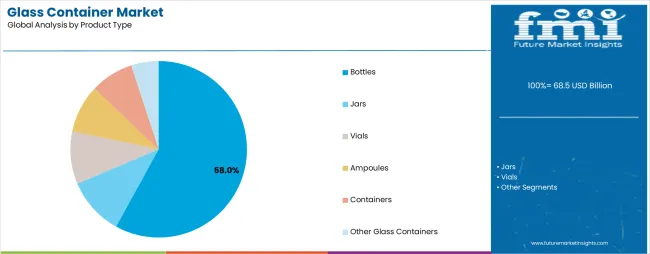
The bottles segment is projected to account for 58% of the glass container market in 2025, reaffirming its position as the leading product category. Manufacturers and brands increasingly utilize bottles for their superior packaging characteristics, established barrier properties, and essential functionality in product preservation applications across diverse beverage categories. Bottles' standardized quality characteristics and proven preservation effectiveness directly address brand requirements for reliable product protection and optimal packaging value in premium applications.
This product segment forms the foundation of modern glass packaging patterns, as it represents the format with the greatest consumer acceptance potential and established compatibility across multiple beverage systems. Brand investments in packaging optimization and quality standardization continue to strengthen adoption among premium-focused organizations. With brands prioritizing product integrity and presentation reliability, bottles align with both quality objectives and performance requirements, making them the central component of comprehensive beverage packaging strategies.
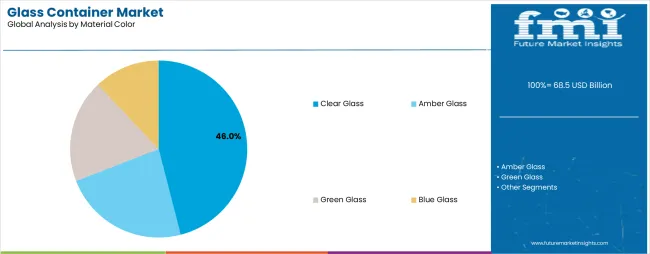
Clear glass is projected to represent 46% of the glass container market growth through 2035, underscoring its critical role as the primary choice for quality-focused brands seeking superior visibility benefits and enhanced product showcase credentials. Brand managers and premium product handlers prefer clear glass for their enhanced transparency standards, proven aesthetic superiority, and ability to maintain exceptional visual profiles while supporting long-term usage during high-value retail experiences. Positioned as essential products for discerning brands, clear glass offerings provide both presentation excellence and quality advantages.
The segment is supported by continuous improvement in glass manufacturing technology and the widespread availability of established production infrastructure that enables quality assurance and premium positioning at the commercial level. Container manufacturers are optimizing clear glass processing methods to support market differentiation and accessible premium pricing. As manufacturing technology continues to advance and brands seek superior presentation solutions, clear glass containers will continue to drive market growth while supporting product visibility and premium packaging strategies.
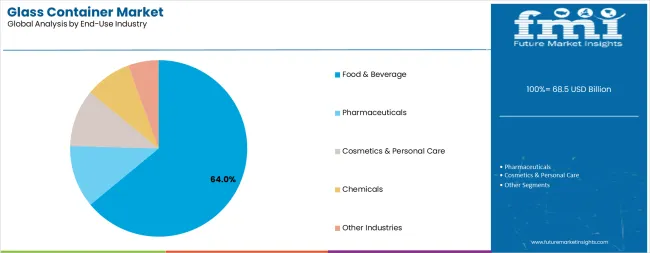
The food & beverage segment is projected to account for 64% of the glass container market in 2025, establishing its dominance as the primary end-use category. Food and beverage manufacturers prioritize glass containers for their exceptional preservation properties, inert characteristics, and ability to maintain product freshness across alcoholic beverages, soft drinks, sauces, and specialty food categories. Glass containers' proven track record in maintaining flavor integrity and product quality directly addresses industry requirements for reliable preservation and premium product positioning.
This end-use segment drives the majority of glass container innovation and production capacity, as food and beverage applications demand consistent quality, regulatory compliance, and consumer appeal. The segment's growth is reinforced by expanding craft beverage markets, premium food categories, and consumer preference for packaging materials that preserve taste and freshness. With food and beverage brands increasingly focused on quality differentiation and premium positioning, glass containers remain the preferred packaging solution for products where preservation and presentation are paramount.
The glass container market is advancing rapidly due to increasing packaging quality consciousness and growing need for premium container choices that emphasize superior preservation outcomes across beverage segments and food applications. The market faces challenges, including higher production costs, weight considerations for transportation applications, and supply chain complexities affecting pricing stability. Innovation in lightweight manufacturing and specialized product development continues to influence market development and expansion patterns.
The growing adoption of glass containers in craft beverage programs and premium product applications is enabling brands to develop packaging patterns that provide distinctive preservation benefits while commanding premium positioning and enhanced quality characteristics. Premium applications provide superior barrier properties while allowing more sophisticated product presentation across various beverage categories. Brands are increasingly recognizing the competitive advantages of glass container positioning for premium product protection and quality-conscious market integration.
Modern glass container manufacturers are incorporating advanced production systems, decoration technologies, and quality management protocols to enhance packaging capabilities, improve brand outcomes, and meet commercial demands for product-specific container solutions. These systems improve container effectiveness while enabling new applications, including integrated labeling and specialized finishing programs. Advanced decoration integration also allows manufacturers to support premium market positioning and packaging leadership beyond traditional container operations.
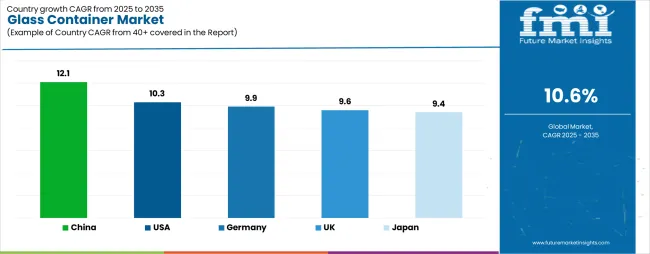
| Country | CAGR (2025 to 2035) |
|---|---|
| USA | 10.3% |
| Germany | 9.9% |
| UK | 9.6% |
| China | 12.1% |
| Japan | 9.4% |
The glass container market is experiencing robust growth globally, with China leading at a 12.1% CAGR through 2035, driven by the expanding beverage sector, growing manufacturing sophistication, and increasing adoption of premium packaging products. The USA follows at 10.3%, supported by rising craft beverage markets, expanding premium food categories, and growing acceptance of quality packaging solutions. Germany shows growth at 9.9%, emphasizing established beverage markets and comprehensive manufacturing development. The UK records 9.6%, focusing on premium packaging products and craft beverage expansion. Japan demonstrates 9.4% growth, prioritizing quality packaging solutions and technological advancement.
The report covers an in-depth analysis of 40+ countries, with top-performing countries highlighted below.
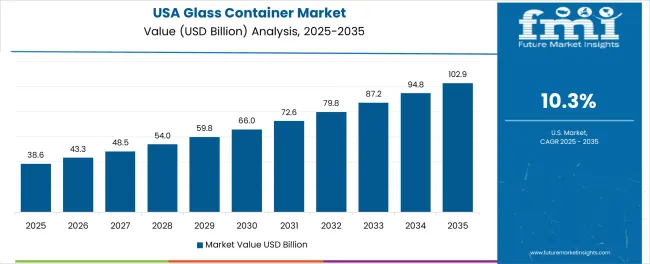
Revenue from glass container consumption and sales in the USA is projected to exhibit exceptional growth with a CAGR of 10.3% through 2035, driven by the country's rapidly expanding craft beverage sector, favorable consumer attitudes toward premium packaging, and initiatives promoting product quality optimization across major retail regions. The USA's position as a leading beverage market and increasing focus on premium packaging development are creating substantial demand for high-quality glass containers in both alcoholic and non-alcoholic markets. Major beverage producers and specialty packaging providers are establishing comprehensive distribution capabilities to serve growing premium demand and emerging quality opportunities.
Revenue from glass container products in Germany is expanding at a CAGR of 9.9%, supported by rising beverage sophistication, growing manufacturing precision, and expanding packaging infrastructure. The country's developing production capabilities and increasing brand investment in quality packaging are driving demand for glass containers across both imported and domestically produced applications. International beverage companies and domestic manufacturers are establishing comprehensive distribution networks to address growing market demand for quality glass containers and premium packaging solutions.
Revenue from glass container products in the UK is projected to grow at a CAGR of 9.6% through 2035, supported by the country's mature beverage market, established quality culture, and leadership in packaging standards. Britain's sophisticated retail infrastructure and strong support for premium packaging are creating steady demand for both traditional and innovative glass container varieties. Leading beverage suppliers and specialty packaging providers are establishing comprehensive operational strategies to serve both domestic markets and growing export opportunities.
Demand for glass container products in China is expected to expand at a CAGR of 12.1% through 2035, driven by the country's emphasis on beverage expansion, manufacturing leadership, and sophisticated production capabilities for products requiring specialized packaging varieties. Chinese manufacturers and distributors consistently seek premium-grade products that enhance product preservation and support commercial operations for both traditional and innovative beverage applications. The country's position as an Asian manufacturing leader continues to drive innovation in specialty glass container applications and premium product standards.
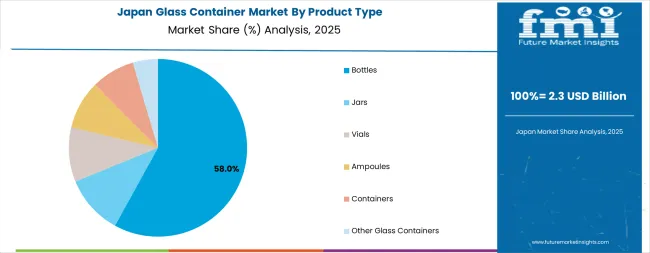
The sale of glass container products in Japan is anticipated to grow at a CAGR of 9.4% through 2035, supported by the country's emphasis on quality manufacturing, packaging safety standards, and advanced technology integration requiring efficient preservation solutions. Japanese brands and beverage handlers prioritize quality performance and precision packaging, making glass containers essential components for both traditional and modern beverage applications. The country's comprehensive manufacturing excellence and advancing consumer patterns support continued market expansion.
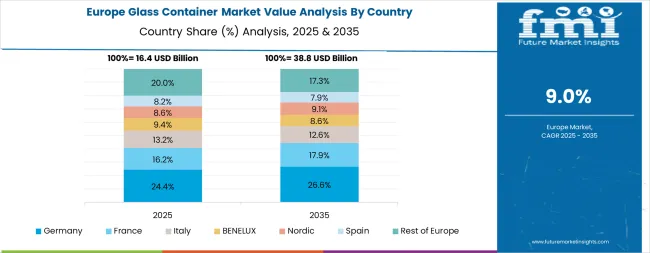
The Europe glass container market is projected to grow from USD 22.8 billion in 2025 to USD 52.4 billion by 2035, recording a CAGR of 8.7% over the forecast period. Germany leads the region with a 33.0% share in 2025, moderating slightly to 32.5% by 2035, supported by its strong beverage culture and demand for premium, professionally manufactured glass containers. The United Kingdom follows with 22.0% in 2025, easing to 21.5% by 2035, driven by a sophisticated beverage market and emphasis on quality and presentation standards. France accounts for 20.0% in 2025, rising to 20.5% by 2035, reflecting steady adoption of premium packaging solutions and beverage consciousness. Italy holds 12.5% in 2025, expanding to 13.0% by 2035 as beverage modernization and specialty product applications grow. Spain contributes 6.5% in 2025, growing to 7.0% by 2035, supported by expanding beverage production and premium packaging handling. The Nordic countries rise from 4.0% in 2025 to 4.5% by 2035 on the back of strong quality adoption and advanced beverage integration. BENELUX remains a stable 2.0% share across both 2025 and 2035, reflecting mature, premium-focused markets.
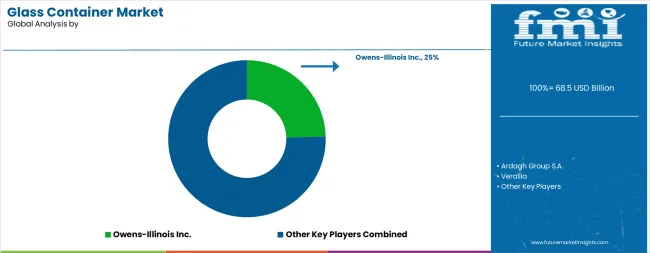
The glass container market is characterized by competition among established packaging companies, specialized glass manufacturers, and integrated packaging solution providers. Companies are investing in manufacturing technologies, advanced production systems, product innovation capabilities, and comprehensive distribution networks to deliver consistent, high-quality, and durable glass containers. Innovation in lightweight production, decoration enhancement, and application-specific product development is central to strengthening market position and customer satisfaction.
Owens-Illinois Inc. leads the market with a strong focus on manufacturing innovation and comprehensive glass container solutions, offering premium packaging with emphasis on quality excellence and production heritage. Ardagh Group S.A. provides specialized container manufacturing capabilities with a focus on global market applications and custom design networks. Verallia delivers integrated packaging solutions with a focus on quality positioning and operational efficiency. Vidrala S.A. specializes in comprehensive glass packaging with an emphasis on beverage applications. Gerresheimer AG focuses on comprehensive pharmaceutical and specialty solutions with advanced manufacturing and premium positioning capabilities.
The success of glass containers in meeting premium packaging demands, brand-driven quality requirements, and presentation integration will not only enhance packaging outcomes but also strengthen global manufacturing capabilities. It will consolidate emerging regions' positions as hubs for efficient container manufacturing and align advanced economies with premium packaging systems. This calls for a concerted effort by all stakeholders -- governments, industry bodies, suppliers, distributors, and investors. Each can be a crucial enabler in preparing the market for its next phase of growth.
| Items | Values |
|---|---|
| Quantitative Units (2025) | USD 68.5 billion |
| Product Type | Bottles, Jars, Vials, Ampoules, Containers, Other Glass Containers |
| Material Color | Clear Glass, Amber Glass, Green Glass, Blue Glass |
| End-Use Industry | Food & Beverage, Pharmaceuticals, Cosmetics & Personal Care, Chemicals, Other Industries |
| Regions Covered | North America, Europe, Asia Pacific, Latin America, Middle East & Africa, Other Regions |
| Countries Covered | United States, Germany, United Kingdom, China, Japan, and 40+ countries |
| Key Companies Profiled | Owens-Illinois Inc., Ardagh Group S.A., Verallia, Vidrala S.A., Gerresheimer AG, and other leading glass container companies |
| Additional Attributes | Dollar sales by product type, material color, end-use industry, and region; regional demand trends, competitive landscape, technological advancements in materials engineering, manufacturing efficiency integration initiatives, quality enhancement programs, and premium product development strategies |
The global glass container market is estimated to be valued at USD 68.5 billion in 2025.
The market size for the glass container market is projected to reach USD 187.6 billion by 2035.
The glass container market is expected to grow at a 10.6% CAGR between 2025 and 2035.
The key product types in glass container market are bottles, jars, vials, ampoules, containers and other glass containers.
In terms of material color, clear glass segment to command 46.0% share in the glass container market in 2025.






Our Research Products

The "Full Research Suite" delivers actionable market intel, deep dives on markets or technologies, so clients act faster, cut risk, and unlock growth.

The Leaderboard benchmarks and ranks top vendors, classifying them as Established Leaders, Leading Challengers, or Disruptors & Challengers.

Locates where complements amplify value and substitutes erode it, forecasting net impact by horizon

We deliver granular, decision-grade intel: market sizing, 5-year forecasts, pricing, adoption, usage, revenue, and operational KPIs—plus competitor tracking, regulation, and value chains—across 60 countries broadly.

Spot the shifts before they hit your P&L. We track inflection points, adoption curves, pricing moves, and ecosystem plays to show where demand is heading, why it is changing, and what to do next across high-growth markets and disruptive tech

Real-time reads of user behavior. We track shifting priorities, perceptions of today’s and next-gen services, and provider experience, then pace how fast tech moves from trial to adoption, blending buyer, consumer, and channel inputs with social signals (#WhySwitch, #UX).

Partner with our analyst team to build a custom report designed around your business priorities. From analysing market trends to assessing competitors or crafting bespoke datasets, we tailor insights to your needs.
Supplier Intelligence
Discovery & Profiling
Capacity & Footprint
Performance & Risk
Compliance & Governance
Commercial Readiness
Who Supplies Whom
Scorecards & Shortlists
Playbooks & Docs
Category Intelligence
Definition & Scope
Demand & Use Cases
Cost Drivers
Market Structure
Supply Chain Map
Trade & Policy
Operating Norms
Deliverables
Buyer Intelligence
Account Basics
Spend & Scope
Procurement Model
Vendor Requirements
Terms & Policies
Entry Strategy
Pain Points & Triggers
Outputs
Pricing Analysis
Benchmarks
Trends
Should-Cost
Indexation
Landed Cost
Commercial Terms
Deliverables
Brand Analysis
Positioning & Value Prop
Share & Presence
Customer Evidence
Go-to-Market
Digital & Reputation
Compliance & Trust
KPIs & Gaps
Outputs
Full Research Suite comprises of:
Market outlook & trends analysis
Interviews & case studies
Strategic recommendations
Vendor profiles & capabilities analysis
5-year forecasts
8 regions and 60+ country-level data splits
Market segment data splits
12 months of continuous data updates
DELIVERED AS:
PDF EXCEL ONLINE
Competitive Overview of Glass Container Market Share
Glass Bottle and Container Market Forecast and Outlook 2025 to 2035
Glass Bottles And Containers Market Size and Share Forecast Outlook 2025 to 2035
Thin Wall Glass Container Market
Pharmaceutical Glass Container Industry Analysis in Europe Size and Share Forecast Outlook 2025 to 2035
Glass Rolling Forming Machine Market Size and Share Forecast Outlook 2025 to 2035
Glass Liquor Bottle Market Size and Share Forecast Outlook 2025 to 2035
Glass Bottles Market Forecast and Outlook 2025 to 2035
Glass Laser Engraving Machine Market Size and Share Forecast Outlook 2025 to 2035
Glass Restoration Kit Market Size and Share Forecast Outlook 2025 to 2035
Glass Additive Market Forecast and Outlook 2025 to 2035
Container-based Firewall Market Size and Share Forecast Outlook 2025 to 2035
Glass Reactor Market Size and Share Forecast Outlook 2025 to 2035
Glass Cosmetic Bottle Market Size and Share Forecast Outlook 2025 to 2035
Glass & Metal Cleaner Market Size and Share Forecast Outlook 2025 to 2035
Glass Product Market Size and Share Forecast Outlook 2025 to 2035
Glassine Paper Market Size and Share Forecast Outlook 2025 to 2035
Glass Fibre Yarn Market Size and Share Forecast Outlook 2025 to 2035
Glass Cloth Electrical Insulation Tape Market Size and Share Forecast Outlook 2025 to 2035
Glass Bonding Adhesive Market Size and Share Forecast Outlook 2025 to 2035

Thank you!
You will receive an email from our Business Development Manager. Please be sure to check your SPAM/JUNK folder too.
Chat With
MaRIA